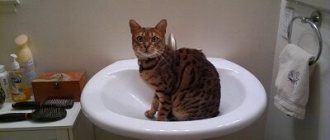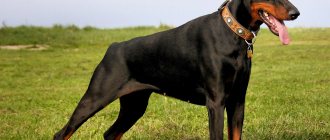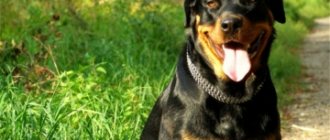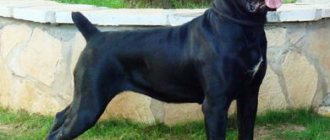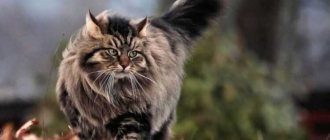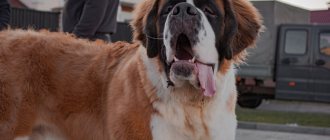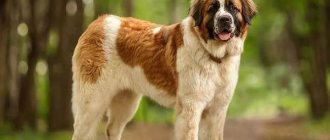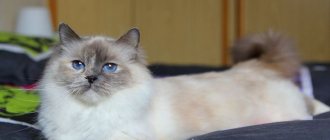Saint Bernards are representatives of one of the largest dog breeds. They have a rather flexible and friendly character, but at the same time they can also be excellent guards.
They feel great on a chain, living in a booth on a personal plot. It is not recommended to have such a dog in a small apartment due to its large size and thick coat, which causes a lot of trouble and inconvenience during periods of shedding.
Origin story
The ancestors of St. Bernards are considered to be Asian Great Danes. They were brought to Europe more than a thousand years ago. Visiting dogs crossed with local canines, giving rise to new breeds. Another possible ancestor is the Roman fighting mastiff. They accompanied the conquerors on long dangerous campaigns.
The real history of the breed began in the 11th century at the Great St. Bernard Pass, in the Swiss Alps. It was named after the monk Bernard, who founded a shelter for people who needed treatment and rest during the difficult transition. The area where the shelter was located was adjacent to the most dangerous section of the route. Travelers often died there from avalanches, hypothermia and robberies. In order to search for people buried under the snow, the monks bred a strong, hardy breed with a fantastic sense of smell. She was named St. Bernard (in honor of the shelter and the pass).
Purposeful selection began only at the end of the 19th century. The first St. Bernard club was founded in 1900. The 50s of the 20th century saw a surge in breeding activity. The standard was approved in 1954. For a long time the breed was known as Alpenhunds, until the name returned to the traditional one - St. Bernard.
Dogs from St. Bernard's Shelter have saved about 2,500 human lives.
Description of the breed
The main feature of the St. Bernard is its enormous, almost gigantic, growth. This is a large, big-boned dog with thick, impenetrable fur from cold winds. Saint Bernards are divided into two types: long-haired and short-haired. The varieties differ in the length and quality of their wool: their structure is almost identical.
Breed standard:
- Height at the withers: for males - up to 90 cm, for females - up to 80 cm. Weight of an adult dog: 60-100 kg (sometimes more).
- The head is massive and large. The forehead is wrinkled and convex. The muzzle is short, the bridge of the nose is blunt. The eyes are brown, moderately set, close to the bridge of the nose. Eyelids are damp. The upper lips are droopy. A full set of strong teeth.
- The ears are hanging and small. The neck is strong, muscular, with dewlap and a thick, dense collar.
- The back is strong and wide. The loin is steep and powerful. The ribs are clearly defined.
- The tail is massive, wide at the base.
- The limbs are widely spaced. They are distinguished by strength and power. Paws are round in shape.
The dog's chin and jaw are designed in such a way that they form loose skin, in the folds of which a lot of saliva accumulates. Therefore, owners should be prepared for profuse drooling.
Shorthaired Saint Bernard
Short-haired St. Bernards have no body features and differ only in the quality of the pile. Their fur is short, thick and dense. It shines and has a fluffy texture. Moderately hard. Does not form the fringe characteristic of a long-haired species. The pile at the base of the tail is thicker than at the end. In general, the dog looks like a smooth-haired subspecies.
Longhaired Saint Bernard
The coat is thick and dense, of medium length. The undercoat is abundant and retains heat well. In the area of the croup and hips, the pile forms soft waves. Otherwise, the coat is straight. The pile on the front legs forms fringes, and on the hips there are thick tufts. The fluffy, massive tail is noteworthy.
Color
The coat is colored red with white spots or white with red spots. There is no standard for the shade of red. The coat is usually a solid color, but white spots are also acceptable. If the hair on the head has a dark brown edge, this adds an extra point to the dog. The standard does not prohibit dark stains on the body.
Desired location of white markings: nose, collar, chest, end of tail. The symmetrical mask and white collar are of particular value.
Kinds
Dangerous work and low prevalence led to the fact that at the beginning of the 19th century the number of St. Bernards decreased to a critical level. To restore numbers, two Newfoundland males were brought to the monastery.
As a result of interspecific crossing, a new variety of St. Bernards appeared: long-haired. The hope that a reinforced coat would improve the working qualities of dogs was not justified. The resulting long-haired variety turned out to be of little use for rescue activities.
The line founded by the Newfoundlands was not stopped. On the contrary, the long-haired version of the dog was favorably received by the public and began to spread quickly. This was facilitated by the intelligence, nobility, goodwill and formidable appearance of the four-legged friend. Today two lines are developing in parallel: short-haired and long-haired.
In the middle of the 20th century, several attempts were made to develop new breeds. The result of crossing the St. Bernard with other large dogs was the appearance of the Moscow Watchdog. It is sometimes called the Moscow St. Bernard .
Until the 80s of the 20th century, there was a periodic influx of St. Bernard blood into this breed. Now the purity of the breed line is maintained. The main task set by the breeders was to enhance the guarding qualities of the dog. They achieved this. It is not for nothing that the name of the breed contains the word “guard”.
Shorthaired Saint Bernard
Character
The main behavioral characteristics of the breed are the rescue instinct and the ability to make independent decisions. Saint Bernards do not show aggression towards others and are ready to help even a stranger. This trait is innate in nature and is inherent even in dogs that have not undergone special training. Saint Bernards are active only during working hours. They usually conserve energy and do not move unless necessary. Therefore, you should not disturb the dog.
Saint Bernards are ideal companions. They adore the family in which they live and try to please all its members. This breed only shows stubbornness during puppyhood. Adult St. Bernards are balanced and obedient. They are highly trainable and easy to train.
Saint Bernards have an internal “compass” and an innate sense of space. They will be able to find their way home, even if they find themselves several hundred kilometers away.
Externally, the St. Bernard resembles a teddy bear. However, he will not tolerate aggression directed at his family members. If he sees that his owners are being attacked, he will instantly rush into battle and begin to fight fiercely with the enemy. Surviving his attack will not be easy.
Saint Bernards need human company and get bored when left alone. At the same time, they get along well with animals. This breed does not suffer from zoo aggression and behaves calmly when walking, not paying attention to cats and passing dogs. In addition, St. Bernards are excellent nannies. They adore children and are ready to give them rides on their backs. These giants are patient with violent manifestations of love and will never offend a child.
There are 3 classes of Saint Bernards
Pet class. Price from 5 to 15,000. These animals have some shortcomings that do not correspond to the parameters of the breed (improper bite, color, etc.).
- These deviations do not pose a threat to the life of the dog itself, but such animals are not suitable for mating.
Breeding class. These are animals that have all the qualities that fit the description of the St. Bernard breed.
- They have minor deviations from the norm, which do not affect the evaluation at exhibitions. Price from 15 to 20,000 rubles.
Show class. Elite individuals. They are perfect, they have no vices or shortcomings. Cost from 30,000.
Care and maintenance
It is not advisable for a St. Bernard to be kept in an apartment. Its impressive size requires freedom of movement. In addition, this breed is known for drooling profusely, which means that saliva will be on all surfaces accessible to the dog. Although the St. Bernard does not need constant exercise, it does need long (but leisurely) walks. The ideal place to live is a private house with adjacent territory. This breed is suitable for aviary keeping, but is sensitive to temperature changes: animals should not be left in the cold or heat. Dogs need a spacious kennel or outbuilding.
An enclosure for a St. Bernard must have an area of at least 10 square meters. It is better to place it at the front of the house. A mandatory requirement is a warm floor. Saint Bernards are prone to joint diseases, so concrete or earthen surfaces are not suitable for them. Slippery floors are no less dangerous.
The dog is left in the enclosure only at night or while away! If the owners of the house, the dog should be involved in their affairs. Otherwise, the animal will suffer from a feeling of uselessness. This is fraught with depression and behavioral disorders.
Saint Bernards are susceptible to eye infections, as well as third eyelid prolapse. Previously, it was completely removed, but modern medicine takes a different path. The third eyelid is still operated on, but instead of removal, the mucous membrane is returned to its place. Eyes should be wiped after each walk and regularly examined for inflammation.
Ears also require careful care. Closed sinks create a favorable environment for the development of pathogenic bacteria. Ears should be inspected every day and cleaned as needed. Cotton pads soaked in warm water or a special lotion are suitable for this. Particular attention is paid to the hygiene of the muzzle and oral cavity. The muzzle is cleaned of adhering debris and excess saliva is wiped off. Teeth are brushed weekly. Nails are trimmed twice a month. More often if necessary.
Grooming
Saint Bernards are the owners of luxurious fur coats. Their hair secretes a special lubricant that has self-cleaning properties. Therefore, it is not advisable to bathe dogs more than 1-2 times a year. Regular washing threatens to damage the protective layer. During bathing, use a special dog shampoo with a neutral pH. The water should reach the bottom of the chest. Temperature – no higher than 40 degrees. After a walk, just wash your paws.
The St. Bernard's coat is dense. This leads to the formation of tangles. To prevent their occurrence, it is recommended to brush your dog every 2-3 days. If the pet lives in an apartment, the procedure is carried out daily. During the shedding period, the dog is brushed every day and more intensively.
For combing, a brush with blunt large teeth is suitable. The fur behind the ears, on the neck, chest, hips, and tail requires special attention. In these areas, the pile is long and soft, which means it gets tangled easily. The dog begins to be combed from the head, gradually going down. The hair on the tail is divided with a straight parting and each part is carefully combed. The tangles are sorted out by hand and then carefully combed.
Feeding
Saint Bernards can be fed high-quality dry food or porridge- and meat-based meals. The main thing is that the diet is properly balanced. Excess calories can cause excess weight during the period of active growth. This will lead to joint diseases. If the owners decide to feed the dog home-cooked meals, they need to include the following products in the pet’s diet:
- raw lean meat - horse meat, elk, beef, lamb;
- limited amount of cooked pork (raw pork may contain worm eggs);
- boiled offal - liver, lungs, kidneys, heart, lamb tripe;
- dark sea fish (horse mackerel, mackerel);
- seafood - shrimp, squid, seaweed;
- raw cartilage and bones;
- kefir, fermented baked milk;
- 1.5 tsp. butter per day;
- carrots, beets, cabbage;
- finely chopped nettle;
- 1 clove of garlic 2 times a week;
- egg yolk 2 times a week;
- buckwheat, rice, rolled oats.
The daily intake of raw meat is 450-500 g. It is recommended to alternate feeding meat and fish. Sea fish is given raw, without bones. If the dog has been accustomed to fish since childhood, then the bones can be left. The fish is given without entrails and fins.
List of prohibited products:
- tubular bones of birds;
- legumes;
- potato;
- River fish;
- fat meat;
- salty;
- sweet;
- smoked;
- spicy;
- flour (from yeast flour).
Eating natural foods requires taking a vitamin-mineral complex. It is prescribed by a veterinarian or experienced breeders.
Dry food must be at least premium class and belong to the line for large breed dogs. Cheap food provokes poisoning, allergies and urolithiasis.
Quality products include:
- Acana;
- Go Natural;
- Now Fresh;
- Grandorf;
- Applaws;
- Orijen;
- CarniLove;
- Farmina N&D;
- Savarra;
The daily value is calculated based on the dog's weight. The packaging of high-quality feed contains appropriate recommendations.
The dog should always have access to fresh water.
To prevent obesity, it is recommended to study the weight table by month:
| Age | Weight |
| 1 month | 3-4 kg |
| 2 months | 7-8 kg |
| 3 months | 10-11 kg |
| 4 months | 14-15 kg |
| 5 months | 18-20 kg |
| 6 months | 23-24 kg |
| 7 months | 27-29 kg |
| 8 months | 32-35 kg |
| 9 months | 38-42 kg |
| 10 months | 47 kg |
| 11months | 55 kg |
| 12 months | 62 kg |
The table provides average data to illustrate normal weight gain.
Feeding recommendations
Saint Bernards have a powerful build and are not adapted to active physical activity. If the diet is unbalanced, they are predisposed to gaining excess weight and obesity, which adversely affects the condition of the tendon-ligament system and joints in young dogs. In older Saint Bernards, errors in feeding lead to the development of acute and chronic diseases of the digestive system. At the same time, natural feeding (homemade food) cannot provide such a large dog with a balanced and complete daily diet. Therefore, when feeding St. Bernards, it is better to use industrial complete food that takes these features into account, for example, a dry balanced diet for large breed puppies with a powerful build - Purina® PRO PLAN® Large Puppy Robust with the OPTISTART® complex, for adult dogs of large breeds with a powerful build - Purina® PRO PLAN® Large Adult Robust with OPTIBALANCE® complex.
Training and education
The Saint Bernard is a well-managed animal, so in this case training at home is possible. You need to start it immediately after the puppy arrives. It is very important to keep your baby off the bed. If he gets used to sleeping in his master's bed, it will be impossible to wean him off. The Saint Bernard needs early socialization. The puppy is walked in crowded places and is also introduced to public transport.
This breed is people-oriented, so training should be built on trust and encouragement.
Saint Bernards are characterized by lethargy and slowness. You'll have to come to terms with this. Dogs are slow to remember commands and adopt different stances. They don't like it when their owner repeats the same thing for a long time. At the same time, St. Bernards remember what they learn for a long time. The ideal age for starting training is 5-6 months. At this time, the puppy is taught standard commands and searching for objects by smell. Further training involves searching for people. If training is difficult, you should immediately contact a dog handler. Otherwise, it will be difficult to control a 90-pound dog.
Nutrition
Babies eat frequently, 6 times a day. As it grows, this amount is reduced to two times. Given the tendency to obesity, it is necessary to monitor nutrition.
List of required products:
- Raw veal or beef 500 grams per day;
- Sea fish can be served raw, river fish requires heat treatment;
- Fermented milk products;
- Boiled porridge with vegetables;
- Egg and crushed shell;
- Bones-butter.
Diseases and life expectancy
Saint Bernards are not the healthiest breed. The rapid growth of puppies requires proper and balanced nutrition, otherwise serious problems will arise with the formation of joints. The breed is also susceptible to infectious, heart and parasitic diseases. The most common ones include:
- bloating;
- dysplasia of the hip and elbow joint;
- dislocation of the kneecap;
- osteosarcoma;
- epilepsy;
- congenital deafness;
- dilated cardiomyopathy;
- lymphoma;
- pyoderma;
- entropion of the eyelid;
- eversion of the eyelid;
- cataract.
Unfortunately, St. Bernards live for a very short time: from 6 to 10 years.
Disease susceptibility
Saint Bernards are predisposed to diseases of the musculoskeletal system: dysplasia of the elbow and hip joints, anterior cruciate ligament disease, injuries, arthritis and arthrosis, Wobbler syndrome (a disorder of the structure of the spine).
St. Bernards have congenital entropion or ectropion of the eyelids, chronic conjunctivitis, otitis media, eczema, and gastric volvulus. These dogs are prone to obesity and heatstroke.
Correct care and regular veterinary monitoring of the dog’s condition reduce the risk of developing many acquired diseases.
How to choose a puppy
The best place to buy a puppy is a specialized nursery. Experienced breeders will take into account the wishes of clients and offer the most suitable baby. It is better to visit several establishments and see puppies from different litters. Choosing a dog is a responsible decision. It will depend on him whether communication with your pet will bring joy or turn into a confrontation of characters.
When choosing a puppy, you need to pay attention to the following:
- physical condition and appearance: the puppy must be well-fed, have no problems with skin and fur, foreign odors, discharge from the nose and eyes;
- dog's gait;
- sociability and temperament (a lethargic and hyperactive puppy is not the norm);
- vaccination card;
- pedigree and health status of parents;
- organizing the puppies' living space;
- relationship between relatives;
- ability to go to the toilet in the right place.
It is not recommended to choose a sick puppy. This is fraught with expensive, lengthy treatment. Nothing guarantees that the owner will be able to save the baby. The early loss of a pet is a difficult ordeal. In addition, you should not encourage irresponsible, indifferent breeders who violate breeding rules and contribute to the birth of sick puppies.
Where to buy and price
Saint Bernard is a popular breed in Russia, so choosing a suitable nursery will not be difficult. You should not buy puppies secondhand or from an advertisement. There is a risk of getting a mixed breed or a sick dog. Kennels guarantee that a puppy will grow into a dog that meets physical and psychological standards.
List of nurseries:
- Gloria-Solo (Murom);
- AlpiNEN Gold (Belgorod);
- Red Guardians of the House (Chelyabinsk);
- Dog kennel House Leon (Rostov-on-Don);
- Tomsk Constellation (Tomsk);
- Amira Platinum (Moscow);
- Crystal St. Bernard (St. Petersburg).
On average, purebred St. Bernard puppies cost from 35,000 to 60,000 rubles. A dog without a pedigree costs from 18,000 rubles.
Nicknames for boys: Argus, Archie, Baron, Butler, Thunder, Marty, Olympus, Oscar, Clark, Polka, Ringo, Chuck. Nicknames for girls: Ada, Bonya, Vesta, Goldie, Dina, Sex, Sophie, Chelsea, Chessie, Elba, Emmy.
Similar breeds
The ancestors of the Saint Bernard have an ancient and complicated history, so it is not surprising that there are several similar breeds. These include:
- St. Bernard and Moscow watchdog. The Moscow watchdog has a dry, strong structure. The lips fit tightly to the teeth, not drooping. It is also easy to distinguish by the dark mask on its face. The Moscow Watchdog is used as a guard, not as a companion. Known for its activity and speed of reaction. Distrustful of strangers.
- Saint Bernard and Alabay. The breeds are very different in appearance, but have similar growth and parameters. The color of the Alabai is most often monochromatic: black, white, straw gray. These dogs are natural shepherds and guards. They have a tough character and are not suitable for the role of companions. Alabaevs cannot be kept in an apartment. What they have in common with St. Bernards is their short life expectancy and joint diseases.
- Saint Bernard and Newfoundland. Both breeds are rescue dogs. St. Bernard carries people out from under the snow rubble, Newf helps drowning people swim out. They are easy to distinguish by color: the St. Bernard is white and red, the Newfoundland is black, white, and brown. The latter is more aggressive and does not need constant communication with people. At the same time, Newfies are patient with small children. Saint Bernard is more aggressive towards its relatives. Both breeds make excellent companions.
The choice of one breed or another depends on the purpose of purchasing a dog. If a person wants to have a protective companion, he should pay attention to Newfies and St. Bernards.
Disqualification
- Aggression, cowardice.
- A pronounced overshot or undershot bite.
- Entropy, ectropy.
- Belmo.
- The height at the withers is below the minimum value.
- Any other coat color.
- Completely white or completely red color.
- Clearly demonstrated physical or behavioral abnormalities.
Note : Males must have two normally developed testes that are fully descended into the scrotum.
- Mating of St. Bernards
- St. Bernard's character
- American type St. Bernard
Interesting Facts
In rescue operations, a pair of dogs is used: the female warms the victim with her body heat, the male runs to the base for help.
Saint Bernards have a hypertrophied rescue instinct. If a dog sees a person lying on the ground, it will try to pick him up or at least turn him over on his back. In case of failure, the St. Bernard will lie down next to him and will warm the victim, while licking his face so that he does not fall asleep.
The first name of the breed, Barry, comes from the German Bären (bears). This breed has a fantastic sense of smell: dogs can smell a human scent at a distance of 3 km (subject to a headwind). St. Bernard takes 7th place in the “Biggest Dog” ranking. The growth of males starts at 70 cm.
average cost
The price of a St. Bernard starts from thirty thousand rubles. The cost of a pet is determined based on its origin (pedigree), prospects (special characteristics) and availability of documents.
At the end of this article, we suggest that you familiarize yourself with photographs of St. Bernards.
Pros and cons of the breed
| + | – |
| Suitable for both active and quiet owners | Molting can occur throughout the year with short breaks. |
| Compatible with cats and other animals | Excessive drooling |
| Great with children | It is not advisable to live in an apartment |
| Does not require a high level of physical activity | Short life expectancy |
| Excellent lifeguards and watchmen | Slow to remember commands |
The Saint Bernard is a friendly, loyal breed bred to save people. These dogs will fit perfectly into families with children and will become indispensable nannies. An additional plus is the low level of aggression and willingness to protect the owners from attack. Saint Bernards need constant communication and careful treatment.

